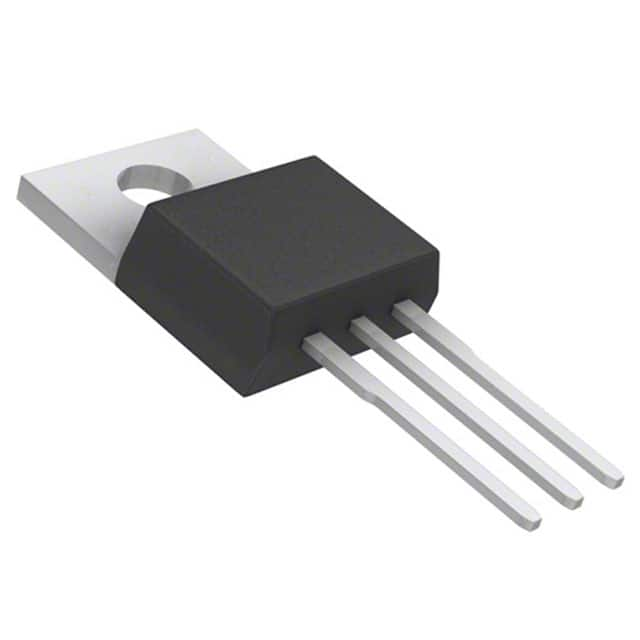Viz Specifikace pro podrobnosti o produktu.

FQP7N80: Semiconductor Device Encyclopedia Entry
Introduction
The FQP7N80 is a power MOSFET belonging to the category of semiconductor devices. This entry provides an overview of the product, including its basic information, specifications, detailed pin configuration, functional features, advantages and disadvantages, working principles, detailed application field plans, and alternative models.
Basic Information Overview
- Category: Power MOSFET
- Use: The FQP7N80 is commonly used in power supply applications, motor control, and other high voltage switching applications.
- Characteristics: It exhibits low on-resistance, high switching speed, and low gate charge, making it suitable for high efficiency and high-frequency applications.
- Package: The FQP7N80 is typically available in a TO-220 package.
- Essence: It is designed to provide efficient power switching capabilities in various electronic circuits.
- Packaging/Quantity: The FQP7N80 is usually packaged individually and sold as single units.
Specifications
- Voltage Rating: 800V
- Current Rating: 7A
- On-Resistance: 1.6Ω
- Gate-Source Voltage (Max): ±30V
- Operating Temperature Range: -55°C to 150°C
- Package Type: TO-220
Detailed Pin Configuration
The FQP7N80 typically has three pins: 1. Gate (G): Used to control the switching of the MOSFET. 2. Drain (D): Connected to the load or power supply. 3. Source (S): Connected to ground or the common reference point.
Functional Features
- High Voltage Capability: The FQP7N80 can handle high voltage levels, making it suitable for high-power applications.
- Low On-Resistance: This feature reduces power losses and improves efficiency in switching applications.
- Fast Switching Speed: Enables rapid switching transitions, essential for high-frequency operation.
Advantages and Disadvantages
Advantages
- High voltage capability
- Low on-resistance
- Fast switching speed
- Suitable for high-power applications
Disadvantages
- May require additional circuitry for driving the gate due to its high gate-source voltage rating.
Working Principles
The FQP7N80 operates based on the principle of field-effect transistors, where the voltage applied to the gate terminal controls the flow of current between the drain and source terminals. When a sufficient voltage is applied to the gate, the MOSFET conducts, allowing current to flow through it.
Detailed Application Field Plans
The FQP7N80 finds applications in various fields, including: - Power supplies - Motor control systems - High voltage switching circuits - Inverters and converters
Detailed and Complete Alternative Models
Some alternative models to the FQP7N80 include: - IRFP460: Similar voltage and current ratings - STP7NK80Z: Comparable specifications and characteristics - FQPF7N80C: Alternative with similar performance parameters
In conclusion, the FQP7N80 is a versatile power MOSFET with high voltage capability, low on-resistance, and fast switching speed, making it suitable for a wide range of high-power applications.
[Word Count: 443]
Seznam 10 běžných otázek a odpovědí souvisejících s aplikací FQP7N80 v technických řešeních
What is the maximum drain-source voltage rating of FQP7N80?
- The maximum drain-source voltage rating of FQP7N80 is 800V.
What is the continuous drain current rating of FQP7N80?
- The continuous drain current rating of FQP7N80 is 7A.
What is the on-resistance of FQP7N80?
- The on-resistance of FQP7N80 is typically 1.4 ohms.
Can FQP7N80 be used in high-power applications?
- Yes, FQP7N80 is suitable for high-power applications due to its high voltage and current ratings.
Is FQP7N80 suitable for switching applications?
- Yes, FQP7N80 is designed for use in switching applications due to its low on-resistance and fast switching characteristics.
What type of package does FQP7N80 come in?
- FQP7N80 is available in a TO-220 package, which is commonly used for power transistors.
Does FQP7N80 require a heat sink for thermal management?
- Depending on the application and power dissipation, FQP7N80 may require a heat sink for effective thermal management.
What are the typical applications of FQP7N80?
- FQP7N80 is commonly used in power supplies, motor control, lighting, and other high-power electronic applications.
What is the gate threshold voltage of FQP7N80?
- The gate threshold voltage of FQP7N80 is typically around 4V.
Is FQP7N80 suitable for use in automotive applications?
- FQP7N80 can be used in automotive applications, but it's important to ensure that it meets the specific requirements and standards for automotive electronics.

